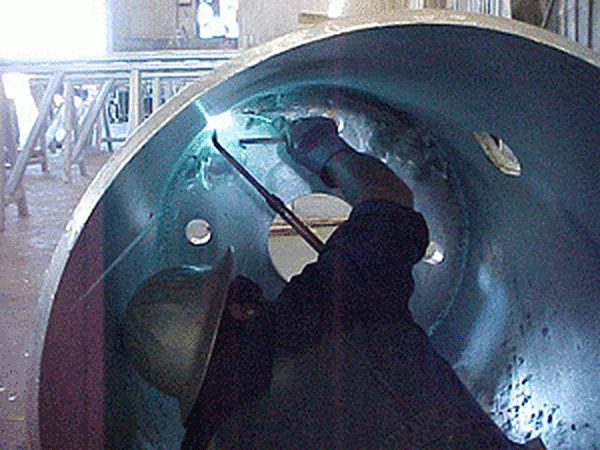Can You Weld Galvanized Steel?
I have never welded galvanized products before. How can you weld galvanized steel?

Welding specifications are derived from the American Welding Society (AWS) 0.19.0, Welding Zinc Coated Steel. This specification, relating to the preparation of the metal and the actual welding process, calls for the weld to be made on steel that is free of zinc, although the component has already been galvanized. The zinc coating should be removed at least 1-4 inches from either side of the intended weld and on both sides of the workpiece.
Grinding is the most effective means of removing galvanized coating. All welds on galvanized surfaces destroy the zinc coatings at the weld site and damage the coating adjacent to the weld. The protective coating must be restored after the welding operation is complete. Restorations should be carried out according to ASTM A780, using paint containing zinc dust or similar permitted products capable of building a zinc rich film to the thickness required by the standard. All welding processes produce fumes and gas to a greater or lesser extent. Allied processes, such as oxyfuel heating and cutting, plasma-arc cutting and air-arc gouging, emit fume and gas. Welding fumes are a controversial topic in today's environmentally conscious culture and should be a concern of all welders and fabricators. Manufacturers and welders must identify the hazards associated with welding coated and uncoated steels and workers must be trained to maintain work practices within the Occupational Safety and Health Administration (OSHA) regulations.
Fumes from welding galvanized steel can contain zinc, iron, lead and other potentially toxic substances fumes composition and amount typically depend on the composition of materials used, as well as the current voltage and process type. Studies on the effects of human exposure to welding fumes present contradictory, if not inconclusive evidence. Quantifying the effects is difficult for several reasons. Working conditions vary widely, even for the same process. For example, a helmet that covers the front of the neck allows less fume than does an open neck helmet. Posture can greatly affect exposures - a welder working with his head in the fume plumb is exposed to much higher concentration than is the welder working with his of the plumb.
Good ventilation minimizes the amount of the fume a worker breathes. Poor ventilation can lead to overexposure. Excessive exposure to lead or zinc constitutes a potential health hazard. The specific precautions that should be followed to avoid this hazard are found in ANZI/ ASC Z- 49.1, Safety In Welding, Cutting and Allied Processes. Always consult this standard before starting to cut or weld metals that contain lead or zinc.
Welding galvanized steel should always be done in well-ventilated locations to prevent the inhalations of fumes, due to the potentially toxic nature or lead and zinc. If adequate ventilation cannot be provided, personnel who may be exposed to fumes must be equipped with hose masks or air respirators. Workers in confined areas, such as deep open tanks, should be provided with a positive air supply that is directed into the tank by a fan or blower to a position below the breathing level. In enclosed areas such as pressure vessels or closed tanks, each worker should be required to an approved air-supplied respirator or mask.

Overexposure to zinc or zinc oxide Can cause metal fume fever, more commonly called "zinc chills, zinc shakes or Galvanize poisoning". The illness begins a few hours after exposure, or more frequently during the night. Some of the symptoms are a sweet taste in the mouth, dryness of the throat, fatigue, nausea, vomiting, chills or fever, rarely exceeding 102-degrees. Complete recovery normally occurs within 24-48 hours. Repeated (exposure to moderate concentrations of zinc oxide in the air has not proven permanently harmful. However, concentrations high enough to cause discomfort to welders and operators should be avoided. Contaminants can be diluted to safe levels, captured at the source, or filtered from the air. Fans dilute contaminants by mixing dear air with the contaminated air. Fume exhaust hoods capture and contain contaminants and raw fumes away from workers. Stationary hoods, typically used in workshops where the welder stands in one location, may not keep the air below the exposure limits, as smoke rises into the welder's breathing zone before entering the hood. However, a source extractor will pull fumes away from the weld area before they can reach the welder's break thing zone. Gun mounted fume extractors remove fumes near the tip of the gun and probably provide the most dexterity. Air cleaners collect and filter particles and recirculate the air.
Welding galvanized steel can be accomplished safely and effectively if proper procedures are followed. Most of these procedures should be standard practices used when welding uncoated or clean steel. The American Welding Society's publication, ANZI/ ASC Z-49.1, Safety, and Cutting in Welding, covers all aspects of safety and health in the welding environment. It contains information on protection of personnel and the general area, ventilation, fire prevention and protection and confined spaces.
© 2025 American Galvanizers Association. The material provided herein has been developed to provide accurate and authoritative information about after-fabrication hot-dip galvanized steel. This material provides general information only and is not intended as a substitute for competent professional examination and verification as to suitability and applicability. The information provided herein is not intended as a representation or warranty on the part of the AGA. Anyone making use of this information assumes all liability arising from such use.

